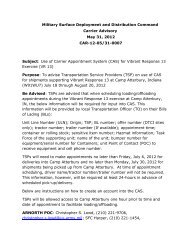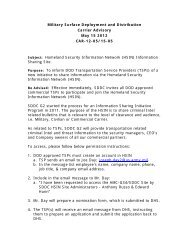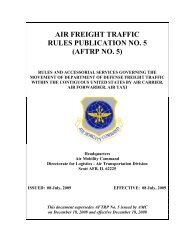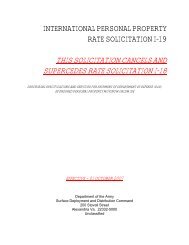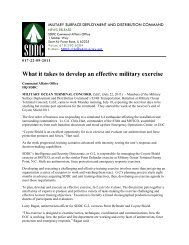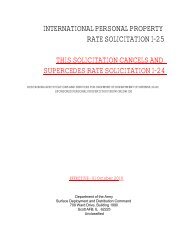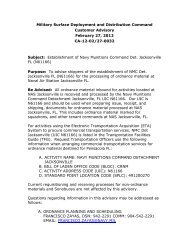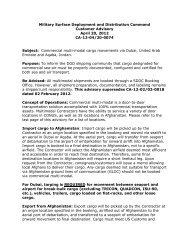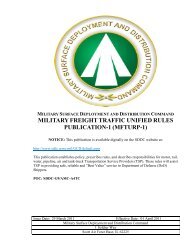Retro-WhitePaper - SDDC - U.S. Army
Retro-WhitePaper - SDDC - U.S. Army
Retro-WhitePaper - SDDC - U.S. Army
- No tags were found...
You also want an ePaper? Increase the reach of your titles
YUMPU automatically turns print PDFs into web optimized ePapers that Google loves.
ChallengeThe R4D movement mission in AFGwill require innovation and creativityto solve the movement challengein order to meet national objectives.Given the physical, environmental,political, enemy threats, operationalconstraints, and now cost factors, U.S.forces must overcome large impedimentsto attain success. Commandersinside the Combined Joint OperationsArea - Afghanistan (CJOA-A)want velocity (move faster) andMilitary Services want volume (lowercost). Balancing speed and cost ina Defense Transportation System ischallenging when given multiple operationalconstraints such as; universalJOPES RDDs, military shippingdocumentation errors, inconsistentdisposition instructions, and CombatantsCommands (COCOMs) mandateddistribution routing that impact coston the MM contract. These factorssub-optimize the use of commerciallyavailable distribution networks, anddrive costly transportation actionsfrom CONUS ports to final destinationlocations. (Figure 1)DiscussionAfghanistan, unlike Iraq, does nothave a theater specific location thatallows surface movement and receptionof outbound cargo. In order tomeet the end of CY14 goal, velocityAfghanistan, unlike Iraq, does not have a theaterspecific location that allows surface movementand reception of outbound cargo. In order tomeet the end of CY14 goal, velocity and volumeare essential to success.and volume are essential to success.<strong>SDDC</strong> created a Velocity-VolumeDistribution <strong>Retro</strong>grade (V2DR)approach to outline our concept tosupport R4D operations. The V2DRis based on the following three corepremises: 1) necessity to move largeamount of cargo in a very short time,2) overcoming multiple impediments,i.e., POL-MIL, weather, route saturation,3) cost conscience transportationoperations. This approach synchronizesJOPES planning with contractacquisition tools to meet operationalrequirements. Focuses on culturalchanges to the traditional RLD/RDDJOPES records building model inorder to optimize commercial bestbusiness practices.V2DR leverages point-to-point movementflow to maximize efficienciesgained through volume and effectivenessthru velocity. At the same timethe acquisition MM contract reflectsthe emphasis on velocity to removecargo from AFG but does not suboptimize carriers established transportationnetwork to allow for volumemovement to CONUS.<strong>SDDC</strong>’s concept in applying enterprisedistribution model – Velocity-Volume Distribution (V2DR).n Adjust TPFDD Letter of Intent(LOI) guidance for retrograde toallow expanded movement timesoutside of CJOA-A in order to allowbetter rail/ship consolidation of rollingstock/non-rolling stock.n Long range Strategic Materielmovements forecasting plan.n Inserting transportation planningearlier in the equipment retrogradeprocess.n Create strategic shipment destinationsof key rolling stock and nonrollingstock items – shipping grid.n Meter CONUS flow times.n Ensure accurate and timely shippingdocumentation (i.e. TransportationControl and Movement Document(TCMD), HAZDECs, etc).n Fully exploit best value routingmethods utilizing the acquisition con-4Delivering Trust



